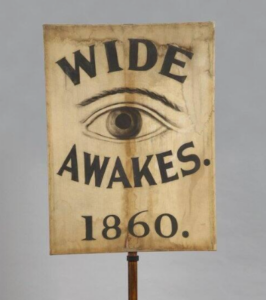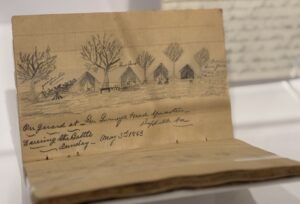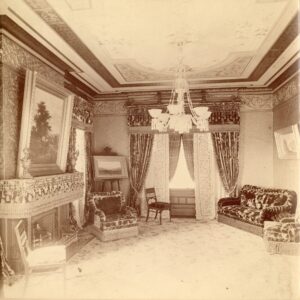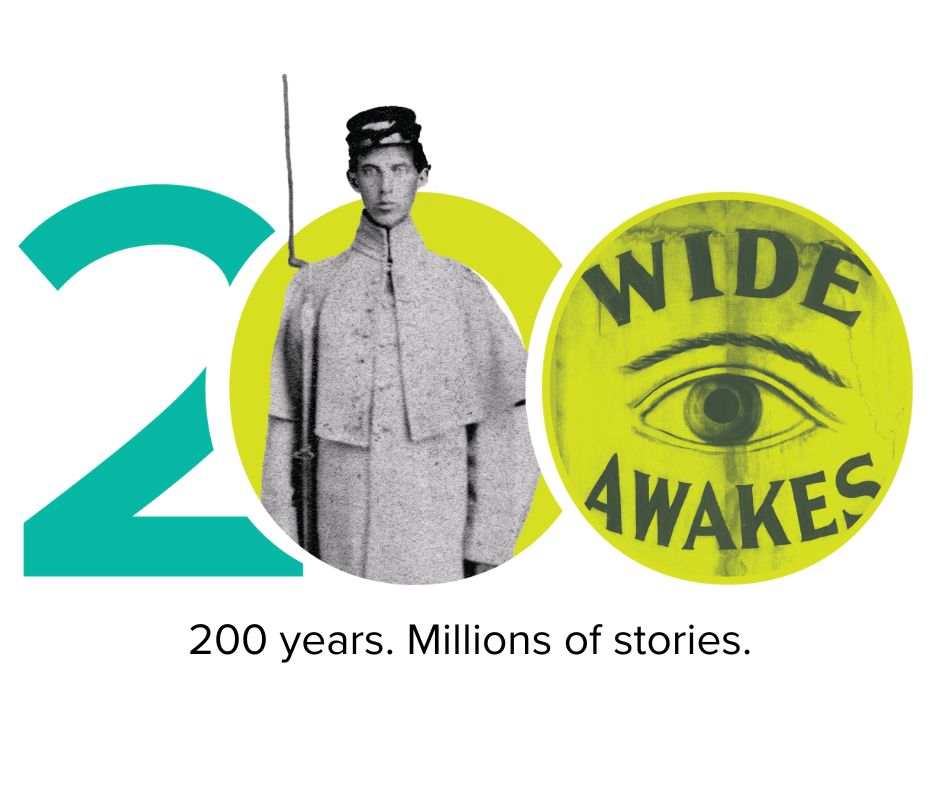Millions of Stories: Edgar Smith Yergason

Behind every object, image, and written word found in the collection at the Connecticut Museum of Culture and History, there are countless individuals from all walks of life with their own stories to tell; their own heritage, interests, views, and dreams.
As we reflect on our 200-year legacy, we aim to highlight just a few of these individuals on a quarterly basis whose memories are safeguarded in the Museum collection and share their stories to represent the scope of who we are as a state and illuminate the present with stories from across Connecticut.

Wide Awakes banner donated by Edgar Yergason’s son, Dr. Robert M. Yergason. Connecticut Museum collection 1922.4.3.
Today, we share the story of a man who could be considered many things: a political radical, a soldier, an interior designer. The Connecticut Museum is honored to hold many of Edgar Smith Yergason’s personal items in its collection, from diaries and letters, to flags and Civil War “relics” that he saved and passed down to his son, Dr. Robert M. Yergason, who donated several of these items to the Museum in 1922. With careful conservation and proper storage, Yergason’s story remains accessible to all. Among these items is a large banner bearing an open eye and the words “WIDE AWAKES. 1860.” This fascinating object marks a significant chapter in Edgar Yergason’s life.
Political Radical
Born in Windham, Connecticut in 1840, Yergason’s political involvement began while he was a clerk at Talcott and Post Dry Goods in Hartford, where he happened to work during a pivotal moment in American history. In 1860, the issue of slavery stood at the forefront of American politics and inspired abolitionists across the state. What’s more, Abraham Lincoln was running for President. In support of Lincoln, anti-slavery leader Cassius Clay held a rally in Hartford where Yergason, just 19 years old at the time, eagerly anticipated joining the crowd to escort Clay back to his hotel.
As historians retell, Yergason was the first to grab a torch during the rally before the parade, spilling oil on his clothes in the process. Yergason then made a makeshift cape out of oil cloth (a waterproof, spill resistant fabric) sold at Talcott and Post to prevent further staining. Four other clerks followed suit, bearing torches and donning oil cloth capes. Suddenly, and somewhat unintentionally uniformed, the five of them caught the attention of rally organizer George Bissell, who put them in front of the parade. From this moment, the “Wide Awakes” and their iconic pageantry were born.
According to his diary, Yergason attended the meeting where the Wide Awakes were officially formed on March 3, 1860. Dubbed “the Hartford Originals,” this small group comprised of Yergason and his peers inspired Americans all the way to California to take political action and vote for Lincoln—an impressive feat, considering the lack of cell phones and social media to accelerate their communication! The Connecticut Museum’s current special exhibition, Wide Awake: Campaigning for Lincoln, explores this Hartford-born movement during a time of great political division in the United States. Much to the credit of the Wide Awakes, Lincoln was elected President.

Diary kept by Edgar Yergason during his Civil War service with the 22nd Connecticut Infantry Regiment. Connecticut Museum collection, MS 96829.
Soldier
But what happens when a current event becomes a historical movement? After the election, with the Wide Awakes having achieved their goal and Lincoln now in office, Yergason’s convictions drew him into the Civil War as a Union soldier. The Museum collection contains documents written by Yergason during his Civil War service in the 22 Connecticut Infantry Regiment. Near Falls Church, Virginia in 1862, just two years after he marched with the Wide Awakes in Connecticut, Yergason marched to war.
In his diaries and letters, Edgar often mentions “seeing the elephant,” a common term given to the experience of war on the front lines. This firsthand account is currently on display at the Museum, where visitors can witness a page from his diary that includes a sketch (pictured right). His captured thoughts provide a unique personal insight into the war, bringing an intimate perspective that adds depth and humanity to such a large-scale event. In a letter to his brother, he writes,
“We are now having a real old Virginia rain storm – has lasted now 3 days and no signs of clearing away – mud ankle deep every where – and watching for an opportunity to get a shot at a Reb – the other night one tried to cross our lines he was halted would not stop – the general fired – the ball hitting him in the forehead killing him instantly – this is one of many instances of which I could tell you”
– Letter to Brother, January 22, 1863, Headquarters 22nd regiment Conn. Camp Burnham

Parlor of a home in Wallingford, interior design by Edgar Yergason. Yergason Family Papers collection, MS82322.
Interior Designer
Fortunately, Yergason lived to see the end of the Civil War. In his later years, with the Wide Awakes and the War behind him, he took an unlikely turn in his career and became a well-known interior designer. Images from the Museum’s collection display the parlor of a Wallingford residence (pictured left), one of Yergason’s many interior design projects. His skills brought him to the White House under Presidents Harrison and McKinley, where he notably designed the Green Room for First Lady Caroline Harrison.
Witnessing Yergason’s story unfold across these objects poses an interesting question: which objects will tell our own story when we are gone, and what items will one day define our own roles in history? The Museum invites you to answer these questions, or simply share your own piece of personal history, sharing it with the hashtag #myCTstory on social media. Every member of the community has a story to tell, and the Museum is pleased to welcome the public to participate in this journey of reflection on the past and inspiration for the future. Remember to use the hashtag #myCTstory and tag @theCTmuseum in your posts!
To learn more about Edgar Yergason and the original Wide Awakes of Hartford, Connecticut, visit our special exhibition, Wide Awakes: Campaigning for Lincoln, on view through May 7, 2025. We also welcome you to join us at the Museum alongside UConn faculty and community partners for a free program, “Encounters: Political Activism in 1860—and 2025,” to dive deeper into the Wide Awakes story to inspire thoughtful discussion on the political connections between Yergason’s time and our own. Learn more and get free tickets to the event here.
Follow along throughout the Connecticut Museum’s 200th anniversary year as we reveal new stories from our vast collection.
Featured graphic: Edgar Smith Yergason in uniform, paired with Wide Awakes banner, Connecticut Museum Collection 1922.4.3.
Location
One Elizabeth Street
Hartford CT, 06105
860.236.5621
Museum Hours:
Tuesday - Saturday 10 am - 5 pm, Thursday until 8 pm
Sunday 12 pm - 5 pm
Research Center Hours:
Tuesday-Saturday 12 pm - 5 pm, Thursday until 8 pm
Always by appointment only.




